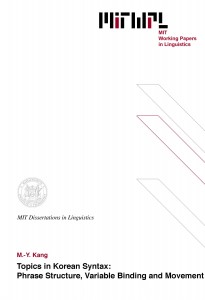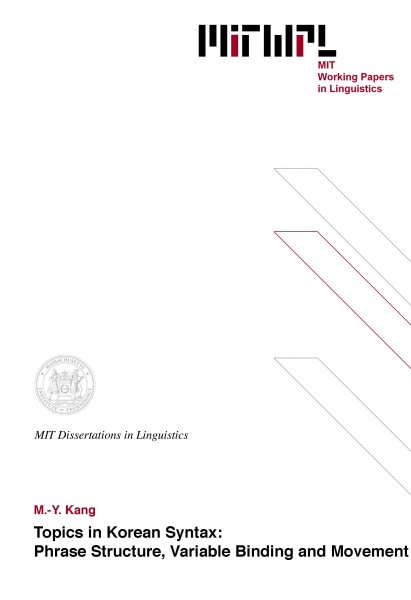Topics in Korean Syntax: Phrase Structure, Variable Binding and Movement
M.-Y. Kang, 1988
This thesis has two parts: Part 1 considers problems related to the phrase structure of Korean; Part 2 investigates problems related to Korean enu"na construction. Part 1 consists of chapters 2 and 3; Part 2 consists of chapters 4 and 5.
In chapter 2, we discuss "VP-focus" constructions and "Long-form" negation constructions in Korean. It will be shown that these Korean constructions utilize the "VP-shell" structure proposed in Larson (1988), with certain extensions. It will also be argues that the element "ki in Korean can be a "nominalizer" of a VP. The Korean progressive construction involving - ko iss " will be analyzed as another instance of the "VP-shell" structure. The notion "morphological closure", a crucial concept in understanding "agglutinating" languages like Korean, will also be introduced in this chapter.
In chapter 3, what is often called "nominalization" structures in Korean, involving "ki/ci, -l/n kes, -l/n ci, -l su, etc., will be investigated. It will be shown that they are not involved in a category-changing process and that they must be viewed as an "NP-shell". It will be argues however that these "NP-shells" must also be viewed as complementizers or simply as syntactic features at D- or S-structure. Hence, the main point of the chapter is that the level of representation at which these elements are analyzed as NP-shells and the level of representation at which these are analyzed as complementizers or as syntactic features must be distinguished. A new level of representation, which is called "Pre-D-structure", will be proposed as a level where these elements are represented as NP-shells. These NP-shells, then, will be functionally determined to be either complementizers or syntactic features during the mapping from the Pre-D-structure to D-structure.
Chapter 4 will discuss the variable binding problems in the Korean enu"na construction, some of which will be identified as a particular type of donkey sentence and others of which will be identified as "Specifier-Binding" constructions. It will be argued that the Korean data support the "Indirect Binding" approach of Haik (1984).
In the final chapter of this thesis, it will be shown that there are two important constraints in the positions that the NP that enu is the specifier of (we will call it "enu NP") can occupy within the relative clause: (i) the "Overt Subject Constraint" (OSC) and (ii) the Wh-island Constraint. I will then try to derive these constraints by assuming an LF movement of enu NP to a position that can be governed by the element "na. It will be argued that the first of these constraints will be derivable with certain assumptions about the specifiers and projections and with a certain revision of the notion of barrier, following an extended version of Fukui & Speas (1986); and that the second of these constraints will be derivable if we adopt the concept "Relativized Minimality", proposed by Rizzi (1987).
Thesis Supervisor: Kenneth Hale
Title: Ferrari P. Ward Professor of Linguistics
Table of Contents
Chapter 1 Introduction
1.1 Introduction 1
1.2 Focus of inquiry 2
1.3 Organization of UG and basic concepts 3
1.4 Summary of thesis 8
Part 1: Phrase Structural Concerns
Chapter 2 VP-structure
2.1 Introduction 12
2.2 Basic properties of VP-focus constructions
2.2.1 Terminology 15
2.2.2 Particle "ki a nominalizer of VP? 20
2.3 Bi-clausal analysis
2.3.1 Introduction 23
2.3.2 Negation in Korean 24
2.3.3 Arguments against bi-clausal analysis
2.3.3.1 Aspect co-occurrence 26
2.3.3.2 Case marking in negation 32
2.4 VP-complementation
2.4.1 V-movement 37
2.4.2 "VP-shell" 42
2.4.3 Larson (1988) 45
2.4.4 Extension of Larson 51
2.4.5 "Upper verb" 53
2.5 Functional elements "ki/-ci and "ko
2.5.1 Introduction 64
2.5.2 Nominalizer "ki 66
2.5.3 Functional element "ko 74
2.6 AGR element "si 80
Chapter 3 "NP-shell"
3.1 Introduction 84
3.2 The suffix "ki and "NP-shell" 84
3.3 Representation of "NP-shell" (I) 90
3.4 Representation of "NP-shell" (II) 94
3.5 Existence of complementizer in Korean syntax 99
3.6 Representation of "NP-shell" (III) 113
3.7 The case of the NP-shell for VP 129
3.8 The prenominal ending "l/n 145
3.9 A speculation: existence of Pre-D-structure 151
Part 2: Problems of enu"na Construction
Chapter 4 "Specifier-Binding" and Donkey Anaphora
4.1 Introduction 158
4.2 Variable binding 159
4.3 Partial review
4.3.1 Theories about "Specifier-Binding" constructions 167
4.3.2 Theories about Donkey Anaphora 176
4.4 Korean data and indirect binding
4.4.1 Morphology of Korean quantifying expressions 187
4.4.2 Korean pronominal binding 192
4.4.3 Particle "na 196
4.4.4 Haik"s (1984) indirect binding 211
4.5 Korean donkey/"Specifier Binding" sentences and generalized
indirect binding
4.5.1 enu/nuku"na and generalized indirect binding 217
4.5.2 Donkey sentences 220
Chapter 5 Enu"na Construction and Movement
5.1 Introduction 226
5.2 Restrictions on the position of enu NP within the relative clause
5.2.1 Unbounded dependency 227
5.2.2 Locality 229
5.2.3 Over subject constraint 235
5.3 Movement of enu NP
5.3.1 Several assumptions 247
5.3.2 Deriving the OSC
5.3.2.1 Introduction 253
5.3.2.2 Specifiers and projections 254
5.3.2.3 OSC 260
5.3.3 Deriving the Wh-island Constraint 278

